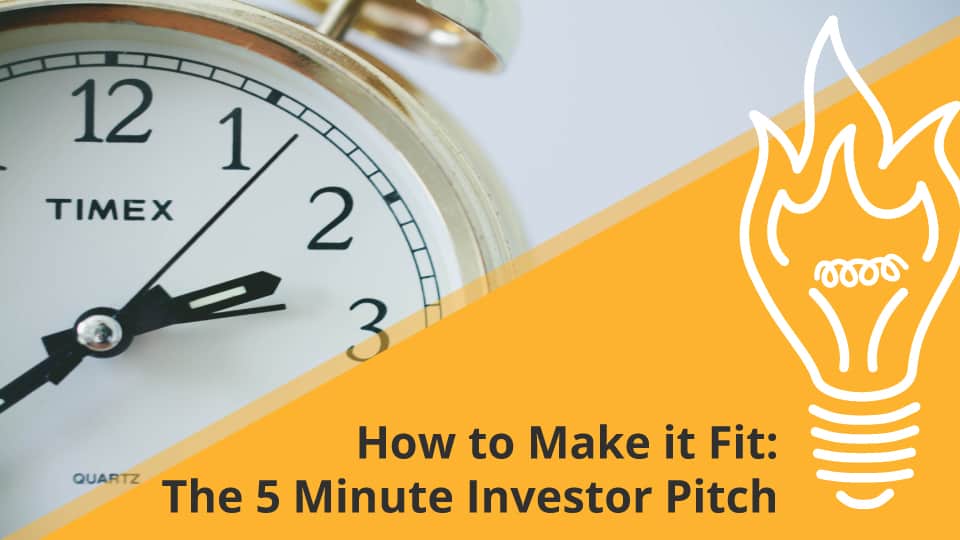How to Make it Fit: Writing a 5 Minute Investor Pitch (Quick Tips) Summary
- Pitching in 5 Minutes or Less Overview
- Identify Key Areas of Information
- Story Board, Develop your Story
- Create Your Deck and Pitch Script
- Creating the Calls to Action and Opening Doors to Next Steps
- The Short Answer
- Wrap up
Pitching in 5 Minutes or Less Overview
We get this 5 minute investor pitch question a lot as people submit applications to Startup Incubators and pitch competitions. It feels like a giant challenge to explain your entire business – everything about it – in a rigid short timeline like 5 minutes. You could probably talk for 5 hours, or 5 days straight about your company. But 5 minutes is a really, really big challenge. Sometimes the requirements are even 1 minute, like with Y-Combinator’s video application submission. This methodology can be adapted to fit any “time crunch” scenario.
First of all, know that getting your pitch down to a tight timeline like 5 minutes or less, IS possible. So don’t despair. It is totally possible to incorporate all the key pieces of information in your pitch to bring your company to life in 5 minutes or even in 1 minute.
So, how do we do it? How do we pitch our company in 5 minutes?

1. Identify Key Areas of Information
First, we want to identify what are the key areas of information that we want to convey in our pitch. If you are familiar with our Business Model Canvas overview and you’ve done the work to understand the visual layout of your business, and this can give you a head-start on pulling out some of the key elements.
Know your Customer’s Challenges
The most important piece of information to make sure you understand and incorporate early on in your pitch is the problem statement, or to put another way “the challenges and pain that your customers face.”
Key questions to Ask to deep dive into Your Customer Challenges:
- Who is our ideal customer and why are they our ideal customer?
- Which issues do our customers have that our business solves?
- What are the current solutions out there and why do they fall short?
- What have you done to connect with customers and explore the issues further?
Understand your Solution in Relation to These Challenges
Then of course we need to solve that problem. Hence the next most important information in your pitch deck and pitch is the solution. Describe your products or services in relation to why they are the best solution for your customers. Focusing on benefits instead of features will keep the frame o your customers and provide a clearer base for the rest of your pitch to build off of.
Key Questions to Ask, to Deep Dive into Your Solution:
- What is our solution?
- What does it looks like?
- How does it work better than what’s out there for solving our customer’s challenges?
- What have you done to validate your product and service with your customers?
Estimate the Size of the Market Opportunity
The market size, or how big the ideal customer base is, will help your potential investors determine how big of an opportunity you are going after. Be specific here. Real, tangible, proven statistics are best. Don’t just list a giant industry number, like “sporting goods market is $XX billion globally.” when you plan to sell only to golfers in the United States. Get specific and be real. Your audience will see past the flashy numbers right away.
Key Questions to Ask, to Deep Dive into Your Market Opportunity:
- Who is your customer? (how old, located where, with what needs?)?
- How many of your customers are there?
- About how often do they buy?
- How much is spent on this solution in your industry today?
- What changes or trends affect the size of your market tomorrow?
Describe the Business Model and Your Progress to Date
Most of the time talking about the solution is not quite enough to understand the business at a business level. Who you sell to, how much you charge, and how you plan to serve them are all important aspects of your business model that should not be missed.
And, don’t forget to talk about traction. What have you achieved so far. What’s been done and what are your plans moving forward. These are super important. If you’re post revenue, you’ll have a lot more fodder for a traction slide. Hard numbers and revenue charts increasing overtime are impressive. Key metrics that prove customers are joining, acquisition costs are dropping and that you’re retaining customers are all great too. But if you’re pre-revenue there is still much you can share. What has been developed, how you have validated that your customers are interested. Are you running a beta, have you talked / worked / polled your customers? Even traction at an industry level can help.
Key Questions to Ask, to Deep Dive into Your Model & Progress:
- What have you accomplished since launch?
- Are you running a Beta? How is it going?
- How do you KNOW your customers are interested in what you’re selling?
- What revenues, customer growth, and other key metrics have you seen?
The Ask
The Ask is whatever the outcome is that you’re seeking at the end of this 5 minute investor pitch. If you’re looking for funding, you need to ASK for it. You don’t have to lay out your entire term sheet, but at least what the entire round will be, and what you plan to accomplish with that money. At pitch competitions, you might not be looking for funding, so instead thin about the other things you could get out of that event, maybe it’s co-founders, or advice, or team members. You need to ask for that as well. This is a good way to wrap up your pitch.
Key Questions to Ask, to Deep Dive into Your Ask:
- What do we need? Where will it get us?
- What else could benefit us?
- Who is at this even and how do we want them to interact with us?

2. Story Board and Develop your Story
Once you’ve identified the big pieces of information that you need to share, you want to start storyboarding it out. Storyboard with the goal of finding best order to convey the key pieces of information we identified above while also telling an engaging story that the audience can get excited about. Tangible examples, case studies, or anecdotes all help to add weight and clarity to your message and keep it engaging.
Key questions to ask during the Story-boarding Stage are:
- What are the things we want to convey?
- How do we tell that story?
- Who are the characters in that story?
- How can we add, and infuse story wherever we can?
Story Development – Important & Challenging
You think 5 minute is short? Your investors’ and audience’s attention spans are even shorter than that. You need to spend every single second of that 5 minutes grabbing their attention, keeping it, and telling a story.
It’s a 5-minute pitch, but you would not believe how short our attention spans are. And, how unlikely your audience is to actually listen the entire time you talk, even for just a 5 minute pitch. There are so many distractions externally (their phone, the birds out the window, what they want to eat for lunch) to internal (like confusion about your pitch, questions your pitch raised in their minds, time spent reading complex and distracting slides).
Your biggest goal with your 5 minute investor pitch should be to get your investors interested, and then listening and waiting for more.
Here at Pitch Deck Fire, we find many of our clients are the most challenged by developing their story. In fact, it’s one of the things that we help with the most in pitch deck design projects. Sometimes you get the best story developed working with someone who isn’t in the weeds of your business. Who isn’t there day to a day.
The key is to make sure you are telling an engaging story and ensuring we’re not just checking off the bullet points: “Yes, I have a problem slide. Yes, I have a solution slide. etc.” Instead you are putting it all together in one cohesive story that’s easy to get passionate and excited about telling. And at the same time conveys those major points and key areas of information.
Storytelling will help you get it down to 5 minutes, because you are forced to focus on the high points and not the nitty gritty detail.
3. Create your Pitch Deck and Pitch Script
After developing your storyboard, you’ll need to develop your pitch deck and pitch script. These are the “execution” of everything you’ve been building and gathering up till this point.
Your pitch deck needs to be a visual representation of this story. For live presentations it should not be too long or too wordy, it should be highly visual. Don’t write a book. Don’t use bullet points. Develop it in a slide design tool, like PowerPoint, for full flexibility in presenting with it.
Write the script for what you’ll be saying as you go through these slides. What are the main points? Tell the story out loud. Make sure to give attention to transitions and revise your story and flow if needed.

4. Creating the Calls to Action and Opening Doors to Next Steps
After the pitch, you always have time to add more depth of information and backup details to interested investors. And, you can always answer questions during a separate Q&A session. So these things do not need to fit into any 5 minute pitch. But instead spend that 5 minutes making sure you’re conveying not only everything about your company that you want to convey, but why it is valuable, why it is interesting. And, do it in a way that attracts, engages, and excites our audience.

The Short Answer
The best advice I can give you to get your message down to a 5 minute investor pitch is to avoid thinking about all the little things, all the staying up late, all the code changes, every little piece of building your business. Many founders are compelled to include that, think that it is important to share. But it’s not. Investors and your audience don’t need all of that information. Instead get up above it. Get a 30,000-foot view of your business and tell a story.
Focus on that, and you can layer in the pieces of more detailed information that you want to convey. But only when you can illustrate clearly where it fits in the overall story. Getting up at that higher level of thinking about your business, you’ll better equipped to spend less than 5 minutes talking about it. The challenge with feel less severe, because it’s about telling a story and you know that you’ll have an opportunity to tell more of that story later.
You’re just opening the door with this 5-minute pitch.
Wrap-up
We hope you’ve enjoyed our take on how to fit it all in a 5 minute investor pitch. I know this is something many of you are dealing with, and I hope that this article gives you the basic outline of what you need to do to succeed.
If any of you have any ideas on how to fit it in 5 minutes or less, or the challenges you face with doing this we would love to hear about it in the comments below. If you have any ideas for the upcoming pitch hack we have a link as well. We love to see your ideas and you might see them covered in an upcoming blog or video post.
Happy pitching!
Suggest an Upcoming Pitch Hack here: https://info.pitchdeckfire.com/pitch-hack-suggestions
For even more pitch hacks visit us here: https://resources.pitchdeckfire.com/tag/pitch-hacks
**Subscribe for more Pitch Hacks in your inbox every week**
Need help with your pitch? Pitch Deck Fire specializes in pitch deck design and presentation preparation. Sign up to speak to a project lead about your pitch deck, sign up here: https://pitchdeckfire.com/pitch-deck-project-initial-steps/
Seeking funding or preparing for a pitch? Find more resources, check out our other helpful articles and posts here: Resources.PitchDeckFire.com






